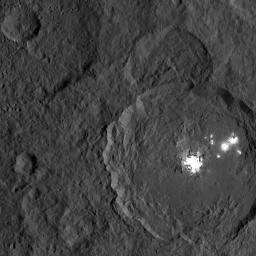
|
Dawn XMO2 Image 7
- Click the image above for a larger view
- Full-Res JPEG (1024 x 1024) (145.3 kB)
- Full-Res TIFF (1024 x 1024) (1.1 MB)
Caption:
This image from NASA's Dawn spacecraft shows Occator Crater on Ceres, with its signature bright areas. Dawn scientists have found that the central bright spot, which harbors the brightest material on Ceres, contains a variety of salts. The brightest parts of these features are overexposed in this image, which had an exposure time intended to capture details in the surrounding terrain. Shorter exposures allow details within the brightest areas to be seen, as in PIA20653 .
Dawn took this image on Oct. 18, 2016, from its second extended-mission science orbit (XMO2), at a distance of about 920 miles (1,480 kilometers) above the surface. The image resolution is about 460 feet (140 meters) per pixel.
Background Info:
Dawn's mission is managed by JPL for NASA's Science Mission Directorate in Washington. Dawn is a project of the directorate's Discovery Program, managed by NASA's Marshall Space Flight Center in Huntsville, Alabama. UCLA is responsible for overall Dawn mission science. Orbital ATK, Inc., in Dulles, Virginia, designed and built the spacecraft. The German Aerospace Center, the Max Planck Institute for Solar System Research, the Italian Space Agency and the Italian National Astrophysical Institute are international partners on the mission team. For a complete list of mission participants, see http://dawn.jpl.nasa.gov/mission .
For more information about the Dawn mission, visit http://dawn.jpl.nasa.gov .
Cataloging Keywords:
| Name | Value | Additional Values |
|---|---|---|
| Target | 1 Ceres | |
| System | Main Belt | |
| Target Type | Dwarf Planet | Asteroid |
| Mission | Dawn | |
| Instrument Host | Dawn | |
| Host Type | Orbiter | |
| Instrument | Framing Camera (FC) | |
| Detector | ||
| Extra Keywords | Crater, Grayscale | |
| Acquisition Date | ||
| Release Date | 2016-11-15 | |
| Date in Caption | 2016-10-18 | |
| Image Credit | NASA/JPL-Caltech/UCLA/MPS/DLR/IDA | |
| Source | photojournal.jpl.nasa.gov/catalog/PIA21227 | |
| Identifier | PIA21227 | |
